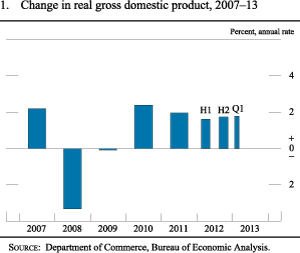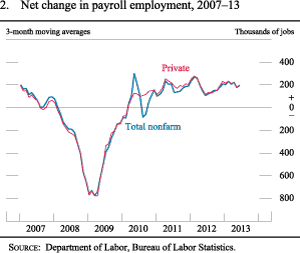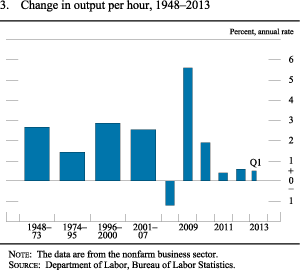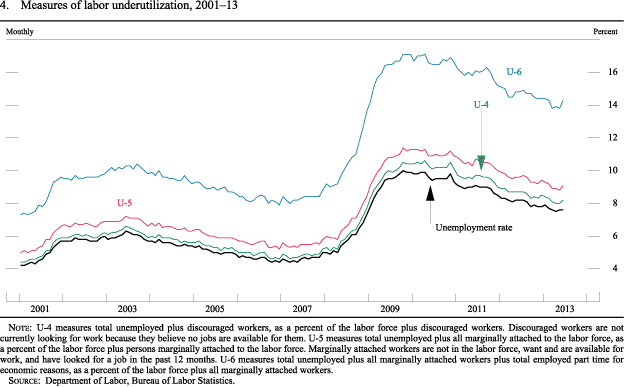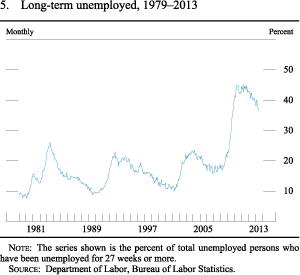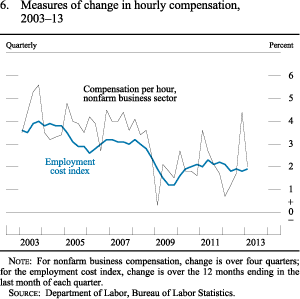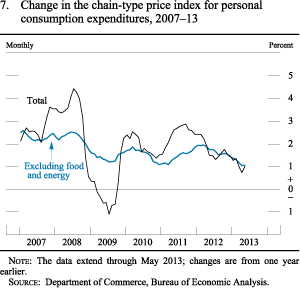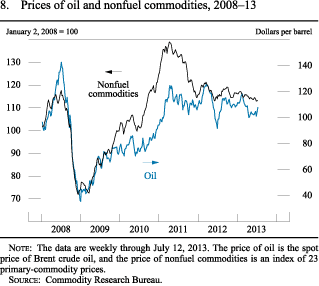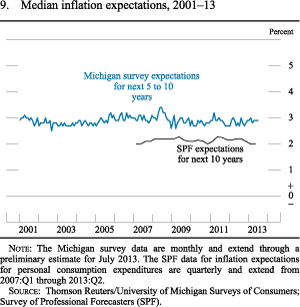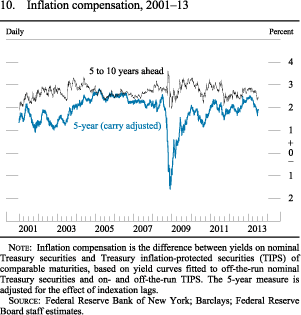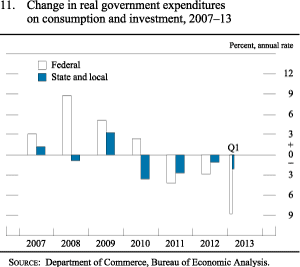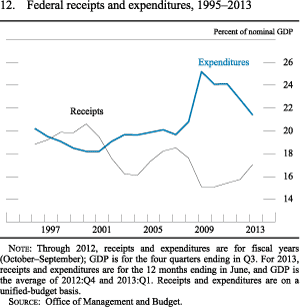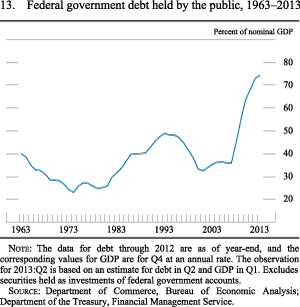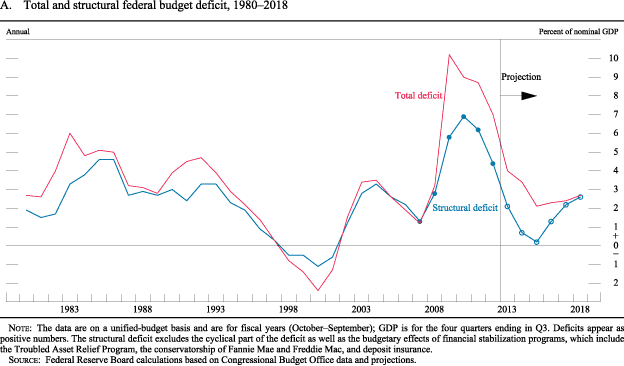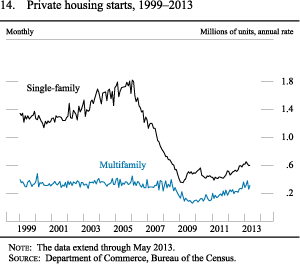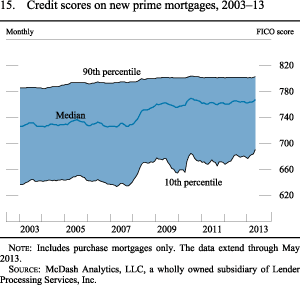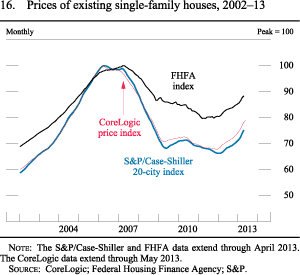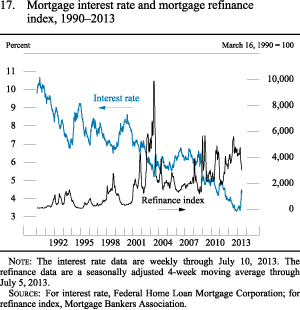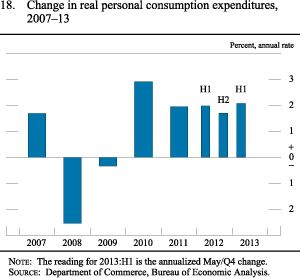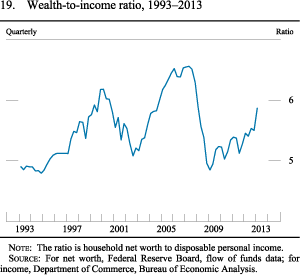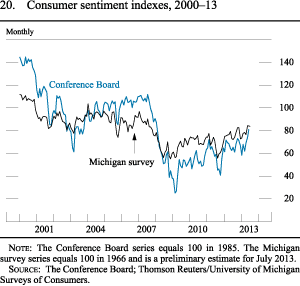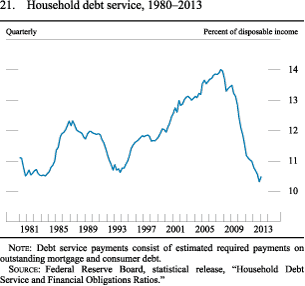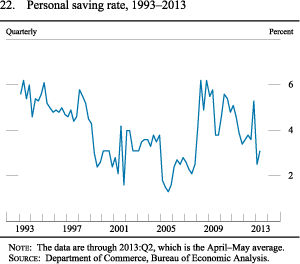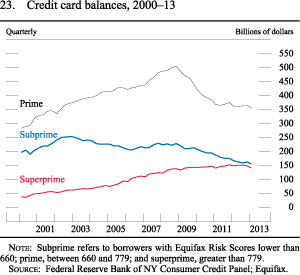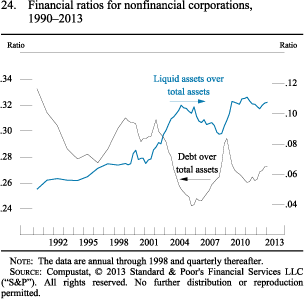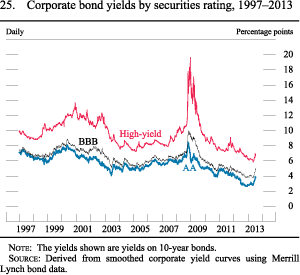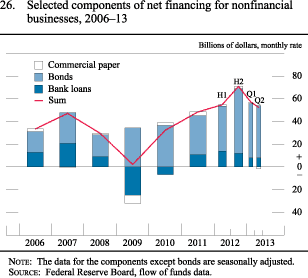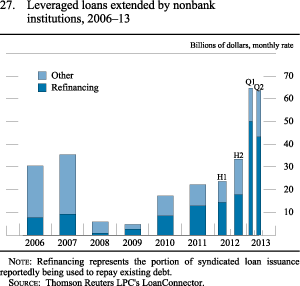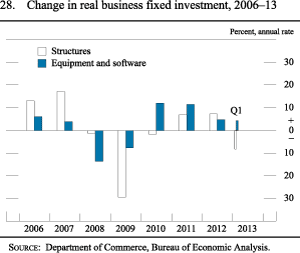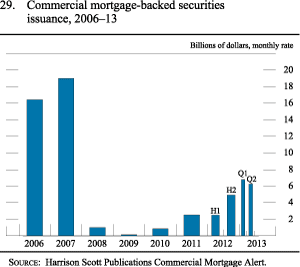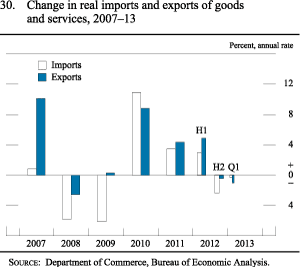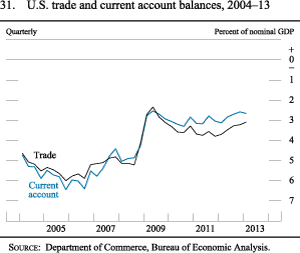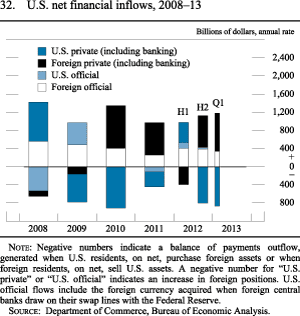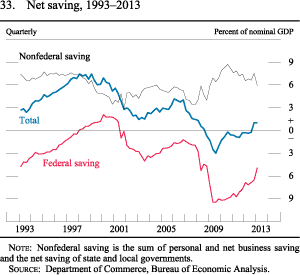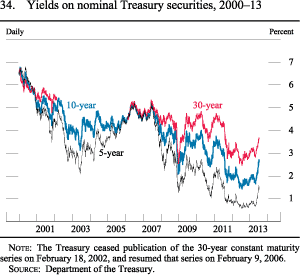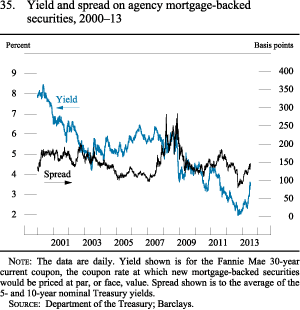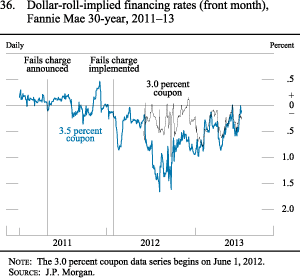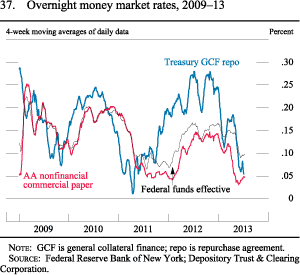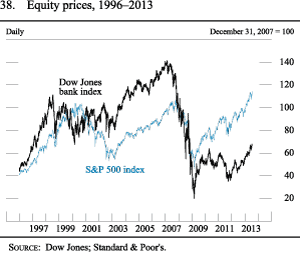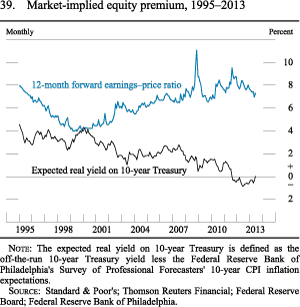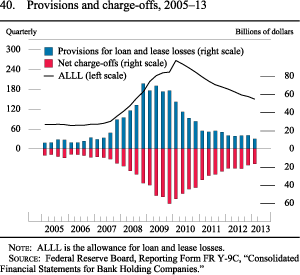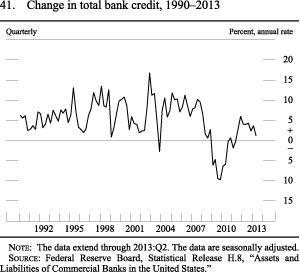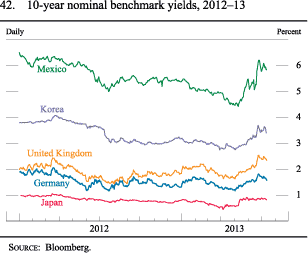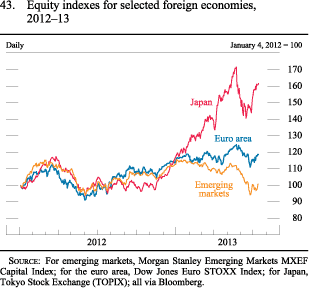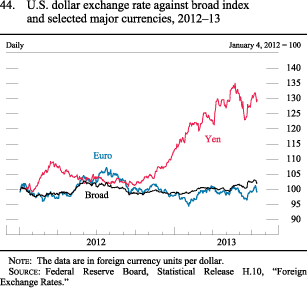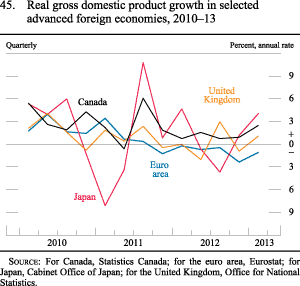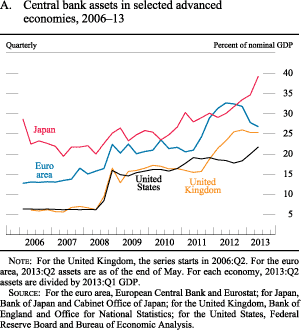- July 17, 2013: Summary
- Part 1
- Part 2
- Part 3
- Abbreviations
- Printable Version (1.11 MB PDF)

Sections of Part 1
Part 1: Recent Economic and Financial Developments
Monetary Policy Report submitted to the Congress on July 17, 2013, pursuant to section 2B of the Federal Reserve ActReal economic activity continued to increase at a moderate pace in the first quarter of 2013, though available indicators suggest that the pace of economic growth was somewhat slower in the second quarter. Federal fiscal policy is imposing a substantial drag on economic growth this year, and subdued growth in foreign economies continues to weigh on export demand. However, some other headwinds have diminished, and interest rates, despite recent increases, have generally remained low by historical standards, importantly due to the ongoing monetary accommodation provided by the Federal Open Market Committee (FOMC). A sustained housing market recovery appears to be under way, and, despite the increase in taxes earlier this year, consumption growth is estimated to have held up reasonably well, supported by higher equity and home prices, more-upbeat consumer sentiment, and the improving jobs situation. Payroll employment has continued to rise at a moderate pace, and various measures of underutilization in labor markets have improved further. But, at 7-1/2 percent in June, the unemployment rate was still well above levels prevailing prior to the recent recession. Meanwhile, consumer price inflation has slowed further this year, in part because of falling energy and import prices and other factors that are expected to prove transitory, and it remains below the FOMC's longer-run objective of 2 percent. Survey measures of longer-term inflation expectations have remained in the fairly narrow ranges seen over the past several years.
Domestic Developments
Economic growth continued at a moderate pace early this year
Output appears to have risen further in the first half of 2013 despite the substantial drag on economic growth from federal fiscal policy this year and the restraint on export demand from subdued foreign growth. Real gross domestic product (GDP) increased at an estimated annual rate of 1-3/4 percent in the first quarter of the year (figure 1), the same as the average pace in 2012, though available indicators point at present to a somewhat smaller gain in the second quarter. Economic activity so far this year has been supported by the continued expansion in demand by U.S. households and businesses, including what appears to be a sustained recovery in the housing market. Private demand has been bolstered by the historically low interest rates and rising prices of houses and other assets, partly associated with the FOMC's continued policy accommodation.
In addition, some of the other headwinds that have held back the economy in recent years have dissipated further. Risks of heightened financial stresses in Europe appear to have diminished somewhat, consumer confidence has improved noticeably, and credit conditions in the United States generally have eased. Nonetheless, tight credit conditions for some households are still likely restraining residential investment and consumer spending, and uncertainty about the foreign outlook continues to represent a downside risk for U.S. financial markets and for sales abroad.
Conditions in the labor market have continued to improve . . .
The labor market has continued to improve gradually. Gains in payroll employment averaged about 200,000 jobs per month over the first half of 2013, slightly above the average increase in each of the previous two years (figure 2). The combination of this year's output and employment increases imply that gains in labor productivity have remained slow. According to the latest published data, output per hour in the nonfarm business sector rose at an annual rate of only 1/2 percent in the first quarter of 2013, similar to its average pace in both 2011 and 2012 (figure 3).
Meanwhile, the unemployment rate declined to 7-1/2 percent in the second quarter of this year from around 8-1/4 percent a year earlier. A variety of alternative, broader measures of labor force underutilization have also improved over the past year, roughly in line with the official unemployment rate (figure 4).
While the unemployment rate and total payroll employment have improved further, the labor force participation rate has continued to decline, on balance. As a result, the employment-population ratio, a measure that combines the unemployment rate and labor force participation rate, has changed little so far this year. To an important extent, the decline in the participation rate likely reflects changing demographics--most notably the increasing share in the population of older persons, who have lower-than-average participation rates--that would have occurred regardless of the strength of the labor market. However, it is also likely that some of the decline in the participation rate reflects an increase in the number of workers who have stopped looking for work because of poor job prospects.1
. . . but considerable slack in labor markets remains . . .
Although labor market conditions have improved moderately so far this year, the job market remains weak overall. The unemployment rate and other measures of labor underutilization are still well above their pre-recession levels, despite payroll employment having now expanded by nearly 7 million jobs since its recent trough and the unemployment rate having fallen 2-1/2 percentage points since its peak. Moreover, unemployment has been unusually concentrated among the long-term unemployed; in June, the fraction of the unemployed who had been out of work for more than six months remained greater than one-third, although this share has continued to edge down (figure 5). In addition, last month, 8 million people, or 5 percent of the workforce, were working part time because they were unable to find full-time work due to economic conditions.
. . . and gains in compensation have been slow
Increases in hourly compensation continue to be restrained by the weak condition of the labor market. The 12-month change in the employment cost index for private industry workers, which measures both wages and the cost to employers of providing benefits, has remained close to 2 percent throughout most of the recovery (figure 6). Compensation per hour in the nonfarm business sector--a measure derived from the labor compensation data in the national income and product accounts--rose 2 percent over the year ending in the first quarter of 2013. Similarly, average hourly earnings for all employees--the timeliest measure of wage developments--increased 2-1/4 percent in nominal terms over the 12 months ending in June. Even with relatively slow productivity gains, the change in unit labor costs faced by firms--an estimate of the extent to which nominal hourly compensation rises in excess of labor productivity--has remained subdued.
Consumer price inflation has been especially low . . .
The price index for personal consumption expenditures (PCE) increased at an annual rate of just 1/2 percent over the first five months of the year, down from a rise of 1-1/2 percent over 2012 and below the FOMC's long-run objective of 2 percent (figure 7). The very low rate of inflation so far this year partly reflects declines in consumer energy prices, but price inflation for other consumer goods and services has also been subdued. Consumer food prices have remained largely unchanged so far this year, and consumer prices excluding food and energy increased at an annual rate of 1 percent in the first five months of this year after rising 1-1/2 percent over 2012. With wages growing slowly and materials prices flat or moving downward, firms have generally not faced cost pressures that they might otherwise try to pass on.
. . . as some transitory factors weighed on prices . . .
In addition to the decline in energy prices, this year's especially low inflation reflects, in part, other special factors that are expected to be transitory. Notably, increases in both medical services prices and the nonmarket component of PCE prices have been unusually low. While the average rate of medical-price inflation as measured by the PCE index has been considerably lower during the past few years than it was earlier, the increase over the first five months of 2013--at below 1/2 percent--has been extraordinarily muted, largely reflecting the effects on medical services prices of cuts in Medicare reimbursements associated with federal budget sequestration. (In contrast, medical services prices in the consumer price index (CPI), which exclude most Medicare payments, have risen at an annual rate of nearly 2 percent so far this year.) Because medical services have a relatively large weight in PCE expenditures (as the PCE price index reflects payments by all payers, not just out-of-pocket expenses as in the CPI), price changes in this component of spending can have a sizable effect on top-line PCE inflation.
The nonmarket PCE price index covers spending components for which market prices are not observed, such as financial services rendered without explicit charge; as a result, the Bureau of Economic Analysis imputes prices for those items. Overall, this nonmarket index declined early this year before moving up again in recent months; however, these prices tend to be volatile and appear to contain little signal for future inflation.
. . . and as oil and other commodity prices declined . . .
Global oil prices have come down, on net, from their February peak of nearly $120 per barrel, though in recent weeks they have increased somewhat from their spring lows to almost $110 per barrel (figure 8). Tensions in the Middle East have likely continued to put upward pressures on crude oil prices, but those pressures have been mitigated by concerns about the strength of oil demand in China and the rest of emerging Asia and by rising oil production in North America. Nonfuel commodity prices have eased since the beginning of the year, also reflecting slowing economic growth in emerging Asia. Notably, the price of iron ore, widely viewed as an indicator of Chinese demand for commodities, has fallen roughly 20 percent since early January. Along with falling commodity prices, prices of non-oil imported goods declined in the first half of 2013, also likely holding down domestic price increases this year.
. . . but longer-term inflation expectations remained in their historical range
The Federal Reserve monitors the public's expectations of inflation, in part because these expectations may influence wage- and price-setting behavior and thus actual inflation. Survey-based measures of longer-term inflation expectations have changed little, on net, so far this year. Median expected inflation over the next 5 to 10 years, as reported in the Thomson Reuters/University of Michigan Surveys of Consumers (Michigan survey), was 2.9 percent in early July, within the narrow range of the past decade (figure 9).2 In the Survey of Professional Forecasters, conducted by the Federal Reserve Bank of Philadelphia, the median expectation for the increase in the PCE price index over the next 10 years was 2 percent in the second quarter of this year, similar to its level in recent years.
Measures of medium- and longer-term inflation compensation derived from the differences between yields on nominal and inflation-protected Treasury securities have declined between 1/4 and 1/2 percentage point so far this year (figure 10). Nonetheless, these measures of inflation compensation also remain within their respective ranges observed over the past several years, as the recent declines reversed the rise over the second half of last year. In general, movements in inflation compensation can reflect not only market participants' expectations of future inflation but also changes in investor risk aversion and fluctuations in the relative liquidity of nominal versus inflation-protected securities; the recent declines in inflation compensation may have been amplified by a reduction in demand for Treasury inflation-protected securities amid increased volatility in fixed-income markets.
Fiscal consolidation has quickened, leading to stronger headwinds but smaller deficits
Fiscal policy at the federal level has tightened significantly this year. As discussed in the box "Economic Effects of Federal Fiscal Policy," fiscal policy changes--including the expiration of the payroll tax cut, the enactment of other tax increases, the effects of the budget caps on discretionary spending, the onset of the sequestration, and the declines in defense spending for overseas military operations--are estimated, collectively, to be exerting a substantial drag on economic activity this year. Even prior to the bulk of the spending cuts associated with the sequestration that started in March, total real federal purchases contracted at an annual rate of nearly 9 percent in the first quarter, reflecting primarily a significant decline in defense spending (figure 11). The sequestration will induce further reductions in real federal expenditures over the next few quarters. For example, many federal agencies have announced plans to furlough workers, especially in the third quarter. However, considerable uncertainty continues to surround the timing of these effects.
These fiscal policy changes--along with the ongoing economic recovery and positive net payments to the Treasury by Fannie Mae and Freddie Mac--have resulted in a narrower federal deficit this year. Nominal outlays have declined substantially as a share of GDP since their peak during the previous recession, and tax receipts have moved up to about 17 percent of GDP, their highest level since the recession (figure 12). As a result, the deficit in the federal unified budget fell to about $500 billion over the first nine months of the current fiscal year, almost $400 billion less than over the same period a year earlier. Accordingly, the Congressional Budget Office projects that the budget deficit for fiscal year 2013 as a whole will be 4 percent of GDP, markedly narrower than the deficit of 7 percent of GDP in fiscal 2012. In addition, as shown in box figure A, the deficit is projected to narrow further over the next couple of years in light of ongoing policy actions and continued improvement in the economy. Despite the substantial decline in the deficit, federal debt held by the public has continued to rise and stood at 75 percent of nominal GDP in the first quarter of 2013 (figure 13).
At the state and local level as well, the strengthening economy has helped foster a gradual improvement in the budget situations of most jurisdictions. In the first quarter of 2013, state tax receipts came in 9 percent higher than a year earlier. (Some of the recent strength in receipts, though, likely reflects tax payments on income that was shifted into 2012 in anticipation of higher federal tax rates this year.) Consistent with improving sector finances, states and municipalities are no longer reducing their workforces; employment in the nonfederal government sector edged up over the first half of the year after contracting only slightly in 2012. However, construction expenditures by these governments have declined significantly further this year. In all, real government purchases at the state and local level decreased in the first quarter and have imposed a drag on the pace of economic growth so far this year.
Economic Effects of Federal Fiscal Policy
Federal fiscal policy has had important effects on the pace of economic growth in recent years. One useful indicator of the stance of fiscal policy is the structural component of the federal budget deficit. The structural deficit excludes the cyclical part of the deficit--that is, changes in government revenues and expenditures that occur automatically over the business cycle. (It also excludes the budgetary effects of financial stabilization programs. 1) Changes in the structural deficit mainly result from fiscal policy actions: Expansionary fiscal policies that can boost near-term economic growth generate increases in the structural deficit, whereas contractionary policies that can temporarily restrain growth generate reductions in the structural deficit.
The evolution of one measure of the structural deficit is shown by the blue line in figure A. 2 During the recession and early in the recovery, federal fiscal policy was quite expansionary, as indicated by the widening of the structural deficit from 1-1/4 percent of gross domestic product (GDP) in fiscal year 2007 to 7 percent in fiscal 2010. The tax cuts and federal spending increases put in place by the Economic Stimulus Act of 2008; the American Recovery and Reinvestment Act of 2009; and the Tax Relief, Unemployment Insurance Reauthorization, and Job Creation Act of 2010 were the primary policy changes contributing to the increase in the structural deficit over this period. 3 In addition, the so-called automatic stabilizers caused the total deficit to be wider than the structural deficit. Starting in 2011, however, fiscal policy transitioned from expansionary to contractionary as the structural deficit began to narrow. The narrowing intensified somewhat last year as the structural deficit decreased from 6-1/4 percent of GDP in 2011 to 4-1/2 percent of GDP in 2012: As some temporary stimulus-related policies expired, federal policymakers shifted to deficit-reduction efforts with the enactment of the Budget Control Act of 2011, and spending on overseas military operations continued to decrease.
This year, the structural deficit is expected to decline a further 2-1/4 percent of GDP. This large decrease reflects the expiration of the temporary payroll tax cut and the enactment of some income tax increases, as well as significant restraint on government expenditures from the budget caps on discretionary spending specified in the Budget Control Act, the onset of the spending sequestration, and further declines in defense spending for overseas operations. The Congressional Budget Office estimated that the deficit-reduction policies in current law generating the 2-1/4 percentage point narrowing in the structural deficit will also restrain the pace of real GDP growth by 1-1/2 percentage points this calendar year, relative to what it would have been otherwise. 4 Under current law, fiscal policy is slated during the next couple of years to continue restraining economic growth, albeit to a diminishing extent compared with the current year, as the structural deficit shrinks further but at a slowing pace.
Despite the substantial near-term narrowing of the structural deficit, the federal government continues to face significant longer-term fiscal pressures. Indeed, under current policies, the structural deficit is projected to begin rising again later in this decade, in large part reflecting the budgetary effects of population aging and rising health-care costs, along with mounting debt service payments.
Footnotes
1. Financial stabilization programs include the Troubled Asset Relief Program (TARP), the conservatorship of Fannie Mae and Freddie Mac, and deposit insurance. These programs are excluded from the structural deficit because, although the programs helped stabilize financial markets and alleviate the crisis, neither their budgetary nor their economic effects are well captured in the deficit figures, owing in part to the accounting procedures used to score these programs in the budget. For example, in the case of the TARP, the budget scores the estimated net subsidy cost of the program (adjusted for market risk) as an outlay. Reassessments of the subsidy cost have led to large fluctuations in TARP-related outlays from year to year that do not reflect changes in policy. Return to text
2. The structural deficit used here is constructed based on estimates by the Congressional Budget Office. For estimates of the cyclical component of the deficit, see Congressional Budget Office (2013), The Effects of Automatic Stabilizers on the Federal Budget as of 2013 (Washington: CBO, March), available at www.cbo.gov/publication/43977. For projections of the total deficit, and of transactions related to financial stabilization programs, for fiscal years 2013-18, see Congressional Budget Office (2013), Updated Budget Projections: Fiscal Years 2013 to 2023 (Washington: CBO, May), available at www.cbo.gov/publication/44172. Return to text
3. Several supplemental appropriations bills enacted during this period also contributed to the increase in the structural deficit. Return to text
4. See Congressional Budget Office (2013), The Budget and Economic Outlook: Fiscal Years 2013 to 2023 (Washington: CBO, February), available at www.cbo.gov/publication/43907. Return to text
Return to textThe housing market recovery continued to gain traction . . .
Activity in the housing market has continued to strengthen, supported by low mortgage rates, sustained job gains, and improved sentiment on the part of potential buyers. In the Michigan survey, many households report that low interest rates and house prices make it a good time to buy a home; a growing percentage of respondents also expect that house price gains will continue. Reflecting the improving demand conditions, sales of both new and existing homes have continued to move up, on net, this year. Construction of new housing units has also trended up over the past year (figure 14), contributing to solid rates of increase in real residential investment in the first half of 2013. Even so, the level of construction activity remains low by historical standards. The steep rise in mortgage interest rates since May could temper the pace of home sales and construction going forward, though the pace of purchase mortgage applications so far has shown no material signs of slowing, even as the pace of refinancing applications has tailed off sharply.
The strengthening in housing demand has occurred despite the fact that mortgage credit remains limited for borrowers without excellent credit scores or the ability to make sizable down payments. Responses to special questions in the Federal Reserve's April Senior Loan Officer Opinion Survey on Bank Lending Practices (SLOOS) suggested that some banks had actually tightened standards over the past year on some loans that are eligible for purchase by the government-sponsored enterprises and loans guaranteed by the Federal Housing Administration, specifically those to borrowers with credit scores below 620 and with low down payments. Indeed, only about 10 percent of new prime mortgage originations made this spring were reported to be associated with FICO scores below 690, compared with a quarter of originations in 2005 (figure 15).
. . . as house prices rose further
House prices, as measured by several national indexes, have increased significantly further since the end of last year (figure 16). In particular, the CoreLogic repeat-sales index rose about 7 percent (not at an annual rate) over the first five months of 2013 to reach its highest level since the third quarter of 2008. Some of the largest recent gains have occurred where the housing market has been most severely depressed. Recent increases notwithstanding, house prices remain far below the peaks reached before the recession, and the national price-to-rent ratio continues to be near its long-run average. Still, the increase in house prices has helped to materially reduce the number of "underwater" mortgages and made households somewhat less likely to default on their mortgages.
Mortgage interest rates increased but remained low by historical standards
Mortgage interest rates have increased significantly in the past couple of months from record lows reached earlier this year (figure 17). However, rates are still low by historical standards, reflecting in part the Federal Reserve's ongoing purchases of mortgage-backed securities (MBS) and highly accommodative overall stance of monetary policy. The spread between rates on conforming mortgages and yields on agency-guaranteed MBS has decreased slightly since the end of 2012.
Low mortgage rates, along with rising house prices, continued to facilitate a significant pace of refinancing for most of the first half of 2013, which has helped households reduce monthly debt service payments. However, refinancing remained difficult for households without solid credit ratings and those with limited home equity. Moreover, as mortgage rates moved higher, refinancing activity began to decrease sharply in May.
Consumer spending has held up despite the drag from tax increases early this year
Real consumption expenditures rose at an annual rate of about 2 percent over the first five months of this year, about the same as in the previous two years (figure 18). These increases have occurred despite higher taxes and have been supported by several factors. The gains this year in house prices and equity values have helped households recover some of the wealth lost during the recession; indeed, the ratio of household net wealth to income is estimated to have moved up sharply in the first quarter (figure 19). In recent months, indicators of consumer sentiment have become more upbeat as well (figure 20). Furthermore, in contrast to mortgage rates, interest rates on auto loans and credit cards have changed little, on balance, since the end of 2012. With interest rates low, the household debt service ratio--the ratio of required principal and interest payments on outstanding household debt to disposable personal income--remained near historical lows (figure 21).
In addition, real disposable personal income has increased slightly, on balance, over the past year, as moderate gains in employment and wages have more than offset the implications for income of changes in tax policy.3 And household purchasing power has been supported so far this year by low consumer price inflation. On balance, moderate increases in spending have outpaced disposable income growth, pushing the personal saving rate down to around 3 percent in recent months, close to the level that prevailed before the recession (figure 22).
The financial conditions of households continued to improve slowly
Although mortgage debt continued to contract amid still-tight credit conditions for some borrowers, consumer credit expanded at an annual rate of about 6 percent in the first quarter of 2013. Student loans, the vast majority of which are guaranteed or originated by the federal government and subject to minimal underwriting criteria, are estimated to have increased rapidly and now total nearly $1 trillion, making them the largest category of consumer indebtedness outside of mortgages. Auto loans are also estimated to have increased at a robust pace. Stable collateral values and favorable conditions in the asset-backed securities market may have contributed to easier standards for such loans. In contrast, revolving consumer credit (primarily credit card lending) was little changed in the first quarter, and standards and terms on credit card loans appeared to remain tight, especially for consumers with less-than-pristine credit histories. For instance, spreads of interest rates on credit card loans over reference interest rates remained historically wide. Consequently, credit card debt extended to consumers with prime credit scores remained well below its pre-crisis levels, while debt extended to those with subprime credit scores--that is, Equifax Risk Scores below 660--continued to trend down (figure 23).
According to the most recent available data, indicators of distress for most types of household debt have declined since the end of 2012. For home mortgages, for example, the fraction of current mortgages becoming 30 or more days delinquent has now reached relatively low levels as a result of strict underwriting conditions for new mortgages as well as improved conditions in housing and labor markets. Measures of late-stage mortgage delinquency, such as the inventory of properties in foreclosure, also improved but remained elevated. Delinquency rates on student loans also remained high, likely reflecting in part the lack of underwriting on the federally backed loans that make up the bulk of the student loans outstanding.
The financial conditions of nonfinancial firms continued to be strong . . .
In the first quarter, the aggregate ratio of liquid to total assets for nonfinancial firms ticked up and remained near its highest level in 20 years, while the aggregate ratio of debt to assets was still well below its average over the same period (figure 24). Strong balance sheets, in turn, have contributed to solid credit quality: Bond default rates, as of June, stayed low by historical standards, and the delinquency rate on commercial and industrial (C&I) loans continued to fall in the first quarter from already low levels. However, over the first half of the year, the volume of nonfinancial corporate bonds that were upgraded by Moody's Investors Service was less than the volume downgraded.
. . . and corporate bond and loan issuance remained robust
With corporate credit quality strong and interest rates near historically low levels through much of the first half of 2013 (figure 25), nonfinancial firms continued to raise funds, especially using longer-duration instruments. The pace of bond issuance by both investment- and speculative-grade nonfinancial firms remained extraordinarily brisk until interest rates rose significantly in May, while nonfinancial commercial paper (CP) outstanding was little changed (figure 26). C&I loans outstanding at commercial banks in the United States continued to expand during the first half of 2013 but at a slower pace than in the second half of 2012, when firms reportedly ramped up their C&I borrowing in part to make larger-than-usual dividend and bonus payments in advance of anticipated year-end tax hikes. A relatively large fraction of respondents to the April SLOOS indicated that, over the preceding three months, they had eased standards and pricing terms for C&I loans to firms of all sizes. Meanwhile, issuance of leveraged loans extended by nonbank institutions in the syndicated loan market was very elevated (figure 27), boosted by strong investor demand for these floating-rate instruments manifested through inflows to loan mutual funds and rapid growth of newly established collateralized loan obligations. More than two-thirds of the proceeds from such syndicated loan issuance, however, were reportedly used to repay existing debt.
Borrowing conditions for small businesses improved, though demand for credit remained subdued
Some indicators of borrowing conditions for small businesses have improved since the end of 2012. According to the surveys conducted by the National Federation of Independent Business (NFIB) during the first half of 2013, the fraction of small businesses that found credit more difficult to obtain than three months prior declined on net. Recent readings from the Federal Reserve's Survey of Terms of Business Lending indicate that the spreads charged by commercial banks on newly originated C&I loans with original amounts less than $1 million--a large share of which likely consist of loans to small businesses--continued to edge down, though they remained elevated.4 However, demand for credit from small firms apparently remained subdued compared with demand from large and middle-market firms. Relatively large fractions of respondents in recent NFIB surveys indicated that they did not have any borrowing needs, and the total dollar volume of business loans with original amounts of $1 million or less outstanding at U.S. commercial banks was little changed in the first quarter.
However, business spending on capital investment has been rising at only a modest pace
Despite the large amount of business borrowing, businesses' capital investment has been rising only modestly. Real spending on equipment and software (E&S) increased at an annual rate of 4 percent in the first quarter after having risen at a similar, below-average pace in 2012 (figure 28); these increases likely reflect the tepid growth in business output over the past year. Shipments and orders of nondefense capital goods and other forward-looking indicators of business spending are consistent with further moderate gains in E&S spending in the spring and summer of this year.
Business investment in structures has also been relatively low so far this year, even apart from a sharp drop-off in expenditures on wind-power facilities following a tax-related burst of construction late last year. The level of investment in drilling and mining structures has stayed elevated, supported by high oil prices and the continued exploitation of new drilling technologies. However, investment in nonresidential buildings continues to be restrained by high vacancy rates for existing properties, low commercial real estate (CRE) prices, and tight financing conditions for new construction. Indeed, banks' holdings of construction and land development loans have contracted every quarter since the first half of 2008.
Despite weak fundamentals, conditions in markets for CRE financing appeared to loosen somewhat. A moderate fraction of banks in the April SLOOS again reported having eased their lending standards on CRE loans, while a somewhat larger fraction continued to report some increase in demand for these loans. In addition, the pace of issuance of commercial mortgage-backed securities has stepped up, on balance, this year, but it remained well below its peak reached in 2007 (figure 29).
Foreign trade has been relatively weak
Export demand, which provided substantial support to domestic activity earlier in the recovery, has weakened since the middle of 2012, partly reflecting subdued foreign economic activity. Real exports of goods and services declined at an annual rate of 1 percent in the first quarter of 2013 (figure 30), though data for the first two months of the second quarter suggest that they rebounded. Exports to Japan have been particularly weak, but those to Canada continue to rise.
Real imports of goods and services edged down in the first quarter after falling substantially in the fourth quarter of 2012. Data for April and May suggest that imports recovered at a moderate pace in the second quarter. Although imports of non-oil goods and services rose, imports of oil declined further as U.S. oil production continued its climb of recent years.
Altogether, net exports were a neutral influence on the growth of real GDP in the first quarter of 2013, and partial data suggest that the same was the case in the second quarter.
The current account deficit remained at about 2-1/2 percent of GDP in the first quarter of 2013 (figure 31), a level little changed since 2009. The current account deficit had narrowed substantially in late 2008 and early 2009 when U.S. imports dropped sharply, in part reflecting the steep decline in oil prices.
In the first quarter of 2013, the current account deficit continued to be financed by strong financial inflows, mostly from purchases of Treasury securities by both foreign official and foreign private investors (Figure 32). Consistent with continued improvement in market sentiment, U.S. investors made further strong purchases of foreign securities, especially equities.
National saving is very low
Net national saving--that is, the saving of U.S. households, businesses, and governments, net of depreciation charges--remains extremely low by historical standards (figure 33). In the first quarter of 2013, net national saving was 1 percent of nominal GDP, up from figures that averaged around zero over the past few years. As discussed earlier, the near-term federal deficit has narrowed because of fiscal policy changes and the economic recovery, and further declines in the federal budget deficit over the next few years should boost national saving somewhat. With the economy still weak and demand for investable funds limited, the low level of national saving is not constraining growth or leading to higher interest rates. However, if low levels of national saving persist over the longer run, they will likely be associated with both low rates of capital formation and heavy borrowing from abroad, limiting the rise in the standard of living for U.S. residents over time.
Financial Developments
The expected path for the federal funds rate in 2014 and 2015 steepened . . .
Market-based measures of the expected future path of the federal funds rate moved higher over the first half of the year, as investors responded to somewhat better-than-expected incoming economic data and to communications from Federal Reserve officials that were seen as suggesting a tighter stance of monetary policy than had been anticipated. The modal path of the federal funds rate--that is, the values for future federal funds rates that market participants see as most likely--derived from interest rate options shifted up considerably, especially around the June FOMC meeting, suggesting that investors may now expect the target funds rate to lift off from its current range significantly earlier than they expected at the end of 2012. However, a part of this increase may have reflected a rise in term premiums associated with increased uncertainty about the monetary policy outlook. According to a survey of primary dealers conducted shortly after the June FOMC meeting by the Open Market Desk at the Federal Reserve Bank of New York, dealers' expectations of the date of liftoff have moved up one quarter since the end of last year, to the second quarter of 2015.5
. . . while yields on longer-term securities increased significantly but remained low by historical standards
Reflecting the same factors, yields on longer-term Treasury securities and agency MBS are also substantially higher now than they were at the end of last year (figures 34 and 35). The rise in longer-term yields appears to have been amplified by a pullback from duration risk as well as technical factors, including rapid changes in trading strategies and positions that had been predicated on the continuation of very low rates and volatility. On balance, yields on 5-, 10-, and 30-year nominal Treasury securities have increased between 65 and 85 basis points, on net, to 1-1/2 percent, 2-1/2 percent, and 3-3/4 percent, respectively, since the end of last year.
Yields on 30-year agency MBS increased more than those on Treasury securities, rising about 1-1/4 percentage points, on net, since the end of 2012, to about 3-1/2 percent. Agency MBS yields also rose significantly more than the yields on comparable nominal Treasury securities after adjusting for the effects of higher interest rates on the likelihood that borrowers will prepay their mortgages (the option-adjusted spread), likely reflecting investors' reassessment of the outlook for the Federal Reserve's MBS purchases as well as subsequent market dynamics.
Nonetheless, yields on longer-term securities continue to be low by historical standards. Those low levels reflect several factors, including subdued inflation expectations as well as still-modest economic growth prospects in the United States and other major developed economies. In addition, despite their recent rise, term premiums--the extra return investors expect to obtain from holding longer-term securities as opposed to holding and rolling over a sequence of short-term securities for the same period--remain small, reflecting both the FOMC's ongoing large-scale asset purchase program and strong demand for longer-term securities from global investors.
Indicators of market functioning in both the Treasury and agency MBS markets were generally solid over the first half of the year. In particular, the Desk's outright purchases of Treasury securities and agency MBS did not appear to have a material adverse effect on liquidity in those markets. For example, available data suggest bid-asked spreads in Treasury and agency MBS markets continued to be in line with recent averages, though some widening has been observed of late amid increased market volatility. In the Treasury market, auctions generally continued to be well received by investors. In the agency MBS market, settlement fails remained low, and implied financing rates in the "dollar roll" market--an indicator of the scarcity of agency MBS for settlement--have drifted up over the past six months, indicating reduced settlement pressures (figure 36).6
Short-term funding markets continued to function well
Conditions in short-term funding markets remained good, with many money market rates having edged down from already low levels since the end of 2012 to near the bottom of the ranges they have occupied since the zero-lower-bound period began (figure 37). In the market for repurchase agreements, bid-asked spreads and haircuts for most collateral types were reportedly little changed, while rates moved down slightly, on net, for general collateral finance repurchase agreements. Despite the high level of reserve balances and the substantially reduced volume of trading in the federal funds market since 2008, the effective federal funds rate has continued to be strongly correlated with these money market rates. Rates on asset-backed commercial paper (ABCP) also fell, and spreads on ABCP with European bank sponsors have generally converged back to those on ABCP with U.S. bank sponsors. Rates on unsecured financial CP for both U.S. and European issuers have remained low, even during the temporary flare-up of concerns about European financial stability surrounding the banking problems in Cyprus, while forward measures of funding spreads have continued to be narrow by historical standards.
Broad equity price indexes increased further . . .
Broad equity price indexes notched substantial gains and reached record levels in nominal terms, boosted by improved market sentiment regarding the economic outlook, the FOMC's sustained highly accommodative monetary policy, and stable expectations about medium-term earnings growth (figure 38). Despite the increased volatility around the time of the June FOMC meeting, as of mid-July, broad measures of equity prices were 18 percent higher, on net, than their levels at the end of 2012. Nonetheless, the spread between the 12-month expected forward earnings-price ratio for the S&P 500 and a long-run real Treasury yield--a rough gauge of the equity risk premium--stayed very elevated by historical standards, suggesting that investors remain somewhat cautious in their attitudes toward equities (figure 39). Outside of the period surrounding the June FOMC meeting, implied volatility for the S&P 500 index, as calculated from option prices, generally remained near the bottom end of the range it has occupied since the onset of the financial crisis.
. . . and market sentiment toward financial institutions continued to strengthen as credit quality improved
On average, the equity prices of domestic financial institutions have outperformed broader equity indexes since the end of last year. Improved investor sentiment toward the financial sector reportedly was driven by perceptions of reduced downside risk in the housing market as well as expectations of continued improvements in credit quality and of increased net interest margins as the yield curve steepened over the past few months. However, prices of real estate investment trust (REIT) shares underperformed, especially after interest rates started rising in May, partially reflecting a broader shift on the part of investors from income-oriented shares toward more cyclically sensitive issues. Shares of mortgage REITs were particularly affected by the sharp rise in Treasury and agency MBS yields.
Equity prices for large domestic banks have increased 24 percent since the end of 2012 (figure 38). However, they have yet to fully recover from the very depressed levels reached during the financial crisis. Standard measures of the profitability of bank holding companies (BHCs) edged down in the first quarter but remained in the upper end of their subdued post-crisis range. BHC profits were held down by modest noninterest income and a further narrowing of net interest margins. By contrast, profits were supported by additional reductions in noninterest expenses and decreases in provisioning for loan losses, as indicators of credit quality improved further in every major asset class. Banks' allowances for loan and lease losses continued to trend down as charge-offs of bad loans once again exceeded provisions in the first quarter (figure 40).
Risk-based capital ratios (based on current Basel I definitions) of the 25 largest BHCs decreased in the first quarter because of the adoption of the new market risk capital rule, while risk-based capital ratios at smaller BHCs edged up.7 Nonetheless, BHCs of all sizes remained well capitalized by historical standards as they prepare for the transition to stricter Basel III requirements (see the box "Developments Related to Financial Stability"). Aggregate credit provided by commercial banks continued to increase in the first half of 2013 (figure 41).
Developments Related to Financial Stability
As highlighted in previous Monetary Policy Reports, the Federal Reserve has devoted increased resources to monitoring potential risks to financial stability. In addition to new regulations to strengthen the financial system, comprehensive monitoring is necessary because the system will evolve in response to new regulations, and because market participants' risk tolerance and perceptions tend to vary with economic and financial conditions. The Federal Reserve's increased monitoring efforts focus on identifying financial vulnerabilities--features of the financial system that can transmit and amplify the effects of unforeseen adverse events. For example, vulnerabilities can arise through excess leverage, through excess maturity transformation--that is, financing long-term assets with short-term debts--and through the complexity and interconnectedness of financial institutions. In recent years, a stronger regulatory framework and an enhanced focus by the private sector on potential risks have contributed to significant reductions in vulnerabilities and a more resilient U.S. financial system. However, important challenges remain, and the Federal Reserve will monitor developments regarding ongoing and emerging financial vulnerabilities.
The financial strength of the banking sector continued to improve last year. Bank holding companies (BHCs) increased the proportion of common equity in their funding base, continuing a trend of recent years. For example, the ratio of tier 1 common equity to risk-weighted assets among the firms participating in the recent Comprehensive Capital Analysis and Review and the stress tests mandated by the Dodd-Frank Wall Street Reform and Consumer Protection Act of 2010 (Dodd-Frank Act) has more than doubled since the first similar stress test in 2009 and totaled 11.3 percent at the beginning of this year. 1 These stress tests are regulatory tools that the Federal Reserve uses to help ensure that financial institutions have robust capital-planning processes and are able to maintain adequate capital even following an extended period of adverse economic conditions. Indeed, capital ratios maintained under the hypothetical "severely adverse" macroeconomic scenario specified in the most recent stress tests suggest that BHCs have become more resilient to possible adverse macroeconomic shocks.
The banking system has also improved its liquidity position relative to pre-crisis levels. For example, large BHCs' holdings of cash and high-quality liquid securities have risen from less than 16 percent of total assets in 2007 to 24 percent in the first quarter of 2013. Further, firms have sharply reduced their dependence on wholesale short-term funding, which proved highly unreliable during the crisis.
In addition, the credit risk of banks' assets has generally declined as banks have tightened lending standards and as some borrowers--both households and nonfinancial firms--have strengthened their financial positions by refinancing their debt at lower interest rates. This improvement has also been aided by the rise in house prices and equity values amid the recovery in economic activity. Consistent with all of these improvements, premiums on BHC credit default swaps (CDS) have fallen by nearly one-half from their 2009 levels. Similarly, systemic risk measures for these firms--which assess the amount of financial stress that would be realized in the event of a sizable financial shock based on CDS premiums, stock prices, and correlations--have declined substantially.
The significant amount of funding channeled through the "shadow banking" sector contributed to the financial system's fragility before the financial crisis, largely because of that sector's reliance on wholesale short-term funds to finance longer-term assets. Activity in this sector contracted significantly in the wake of the crisis and has expanded only moderately since the post-crisis trough. The risks inherent in some forms of shadow banking have been addressed through tighter banking regulations that require more recognition of exposures to off-balance-sheet vehicles, such as asset-backed commercial paper conduits. Nonetheless, significant vulnerabilities associated with wholesale short-term funding remain.
While the extended period of low interest rates has contributed to improved economic conditions and increased resiliency in the financial sector, it could also lead investors to "reach for yield" through excessive leverage, duration risk, credit risk, or other forms of risk-taking. There are signs that the low level of interest rates, as well as improved investor sentiment, has contributed to a modest pickup in leverage and maturity transformation in some markets. However, the recent rise in interest rates and volatility may have led some investors to reevaluate their risk-taking behavior.
Securitization markets grew rapidly over the past year and a half, as investors reportedly increased their exposure to structured finance products in order to boost returns. New U.S. securitization issuance excluding agency residential mortgage-backed securities (MBS) was roughly $500 billion (at an annual rate) in the first quarter, up sharply from the level a year ago but still well below the peak of over $2 trillion reached before the crisis. Collateralized loan obligations and commercial mortgage-backed securities (CMBS) accounted for a substantial part of the increase. Dealer responses in the June Senior Credit Officer Opinion Survey on Dealer Financing Terms indicate that demand for funding of securitized products, such as non-agency residential MBS and CMBS, had increased, suggesting some investments were being funded with short-term debt. 2
In addition, low Treasury yields likely boosted the pace of investment in corporate bond and loan funds and contributed to sizable issuance of high-yield bonds and syndicated leveraged loans this year. However, spreads of yields on corporate bonds relative to those on comparable-maturity Treasury securities were not unusually narrow by historical standards, and purchases generally do not appear to have been financed with leverage or short-term funding, which should limit the risk of a disorderly unwind. As Treasury yields have risen since the beginning of May, corporate bond funds have experienced substantial outflows and bond yields have risen, although spreads over Treasury securities have posted small mixed changes. For syndicated leveraged loans, underwriting standards, such as the number of covenants and required debt-to-earnings multiples, have been easing, and continued flows to loan funds suggest pressures in underwriting may continue. Banking supervisors are currently working on implementing new supervisory guidance on leveraged lending practices, which should help mitigate the potential for a buildup of vulnerabilities. 3
Agency mortgage real estate investment trusts (agency REITs) are another area where investors have displayed a willingness to take on risk to achieve higher returns. Agency REITs purchase agency MBS, funded largely by relatively short-term repurchase agreements, and thus combine high leverage with extensive maturity transformation, creating the potential to disrupt MBS markets if, for instance, rates were to rise sharply. Amid the recent increase in interest rates and widening of MBS spreads, stock prices of agency REITs have fallen about 20 percent, and some of these firms have reportedly sold assets to offset the resulting increase in their leverage. To date, sales by these agency REITs and other funds with similar positions reportedly have amplified the initial rise in rates and spreads, but market functioning has not been impaired.
At commercial banking firms, the low interest rate environment in recent years has been pressuring net interest margins, and some firms appear to have extended the duration of their securities holdings to boost profits. Supervisors have been working with banks on interest rate risk-management practices to ensure that the banks' practices comply with the interagency advisory that was issued in 2010. 4Improved practices should make the banks more resilient to unexpected interest rate shocks. The low interest rates also appear to be pressuring profits among life insurance companies, and some insurers have added marginally more credit and liquidity risk to their asset portfolios.
The Federal Reserve has continued to make progress on financial reform. The Federal Reserve recently finalized its proposal to implement the Basel III capital requirements. The final rule promotes a stronger banking system by increasing the quantity and quality of required regulatory capital, which is accomplished by setting a new tier 1 common equity capital ratio of 4.5 percent of risk-weighted assets (RWA), a capital conservation buffer of 2.5 percent of RWA, and strict eligibility criteria for regulatory capital instruments. In addition, the rule contains a supplementary minimum leverage ratio and a countercyclical capital buffer for large and internationally active banking organizations. Furthermore, the Federal Reserve is working this year toward finalization of additional rules that would implement sections 165 and 166 of the Dodd-Frank Act, a broad set of enhanced prudential standards for BHCs with total assets of $50 billion or more and systemically important nonbank financial companies designated by the Financial Stability Oversight Council (FSOC). The rules relating to resolution planning and stress testing are already completed, and the Federal Reserve is working to finalize rules for capital requirements, liquidity requirements, single-counterparty credit limits, an early remediation regime, and risk-management requirements. Finally, the Federal Reserve is preparing to regulate and supervise systemically important nonbank financial firms. Recently, the FSOC designated two nonbank financial firms and it has proposed the designation of a third firm, which has requested a hearing before the council. 5
Footnotes
1. Information on these stress tests and the Comprehensive Capital Analysis and Review is available on the Federal Reserve Board's website at www.federalreserve.gov/bankinforeg/stress-tests-capital-planning.htm. Return to text
2. The survey is available on the Federal Reserve Board's website at www.federalreserve.gov/econresdata/releases/scoos.htm. Return to text
3. See Board of Governors of the Federal Reserve System, Division of Banking Supervision and Regulation (2013), "Interagency Guidance on Leveraged Lending," Supervision and Regulation Letter SR 13-3 (March 21), www.federalreserve.gov/bankinforeg/srletters/sr1303.htm. Return to text
4. See Board of Governors of the Federal Reserve System, Division of Banking Supervision and Regulation (2010), "Interagency Advisory on Interest Rate Risk," Supervision and Regulation Letter SR 10-1 (January 11), www.federalreserve.gov/boarddocs/srletters/2010/sr1001.htm. Return to text
5. U.S. Department of the Treasury (2013), "Financial Stability Oversight Council Makes First Nonbank Financial Company Designations to Address Potential Threats to Financial Stability," press release, July 9, www.treasury.gov/press-center/press-releases/Pages/jl2004.aspx. Return to text
Return to textM2 rose at a more moderate rate, but balances remain elevated
M2 has increased at an annual rate of about 4-3/4 percent since the end of 2012, notably slower than the pace registered last year. However, holdings of M2 assets--including their largest component, liquid deposits--remained elevated relative to what would have been expected based on historical relationships with nominal income and interest rates, likely due to investors' continued preference to hold safe and liquid assets. The monetary base--which is equal to the sum of currency and reserve balances--increased briskly over the first half of the year, driven mainly by the significant rise in reserve balances due to the Federal Reserve's asset purchases.
International Developments
Foreign bond yields have risen and asset prices have declined, on net, especially in emerging market economies
Foreign benchmark sovereign yields have moved somewhat higher, on net, since the beginning of the year (figure 42). Rates moved lower in March and April, in part reflecting weak incoming data on activity; anticipation of the Bank of Japan's (BOJ) asset purchase program may have also contributed to declining Japanese government bond (JGB) yields early in the year. Since early May, however, as with U.S. Treasury securities, sovereign yields have risen worldwide, as investors responded to better-than-expected U.S. economic data and to Federal Reserve communications about monetary policy. Sovereign yields are up, on net, in Europe, Japan, and Canada and have increased substantially in Korea, Mexico, and other emerging market economies (EMEs).
Equity indexes in the major advanced foreign economies (AFEs) rose earlier in the year (figure 43), especially in Japan, where stock prices continued to soar as Prime Minister Abe's ambitious stimulus program began to take shape. However, since mid-May, equity prices have declined on net. Corporate bond issuance eased somewhat in June as rates climbed higher, but year-to-date issuance totals are still strong relative to recent years. Since the start of the year, sovereign and corporate credit spreads have narrowed slightly. Financial stresses in Europe have remained well below their highs last year despite banking problems in Cyprus and political tensions in several other European countries.
The significantly higher interest rates in EMEs have been accompanied by sharp moves in other EME financial markets. Since mid-May, stock prices have declined and credit spreads have widened markedly. EME bond and equity funds have also experienced sizable outflows, as investors reassessed the economic outlook in these economies as well as the returns on EME assets relative to those in advanced economies.
The improved sentiment toward the U.S. economic outlook and anticipation of less-accommodative monetary policy have pushed the U.S. dollar higher against a broad set of currencies since the end of 2012 (figure 44). In particular, the dollar has appreciated sharply against the Japanese yen, on net, as the BOJ adopted a more accommodative monetary policy stance.
Activity in the advanced foreign economies remained subdued despite a pickup . . .
Activity in the AFEs improved to a still-muted pace in the first half of 2013 (figure 45), supported in part by stronger exports and the easing in financial stresses in Europe. The euro-area economy shrank further in the first quarter, but the pace of contraction moderated as consumption stabilized. In the United Kingdom, real GDP resumed growing, at a 1-1/4 percent pace, in the first quarter; retail sales and the purchasing managers index (PMI) suggest that growth firmed in the second quarter. First-quarter activity accelerated in Japan, reflecting a strong rebound of exports and a pickup in consumption. Canadian growth also firmed in the first quarter, and the labor market notched solid employment gains through the second quarter.
With activity weak and inflationary pressures low, several foreign central banks took additional steps to support their economies. (See the box "The Expansion of Central Bank Balance Sheets" for a broader overview of central bank actions.) The European Central Bank (ECB) and the Reserve Bank of Australia lowered their main policy rates, and the ECB stated after its July meeting that it will keep key policy rates low "for an extended period." The Bank of England extended its Funding for Lending Scheme until January 2015 and increased banks' incentives to lend to small and medium-sized businesses. In April, the BOJ announced a sharp rise in its purchases of JGBs and other assets, as well as an extension of the maturity of the JGBs that it purchases.
Authorities in some AFEs also eased fiscal policy in response to still-subdued activity. The Japanese parliament approved a fiscal stimulus package worth about 2 percent of GDP, with the bulk of the spending directed to infrastructure projects. European authorities postponed deadlines for several euro-area countries, including France and Spain, to reduce fiscal deficits below 3 percent of GDP.
The Expansion of Central Bank Balance Sheets
The severity of the recession associated with the global financial crisis led central banks in some of the advanced economies to take policy measures that drove short-term market interest rates nearly to zero. As the recession dragged on, however, several major central banks--including the Federal Reserve, the Bank of England (BOE), the Bank of Japan (BOJ), and the European Central Bank (ECB)--sought to provide further economic stimulus through the adoption of unconventional policies that aimed to reduce longer-term interest rates and ease financial conditions more generally. These policies, which included purchases of longer-term assets and repurchase operations with extended terms to maturity, left the central banks with balance sheets of unprecedented size. Total assets of the Federal Reserve rose from about 6 percent of gross domestic product (GDP) (around $870 billion) in the summer of 2007 to 22 percent of GDP ($3.5 trillion) as of June 2013. As shown in figure A, the assets of the BOE, BOJ, and ECB also increased markedly relative to the sizes of their economies. This box offers some detail on the circumstances and policies that led to the balance sheet expansions for these central banks.
Like the Federal Reserve, the BOE began its asset purchases relatively soon after the advent of the global financial crisis. Also like the Federal Reserve, the goals of the BOE's purchases were to help lower longer-term interest rates and to ease financial conditions more broadly, thereby providing further support for economic growth. During its initial program, between March 2009 and January 2010, the BOE bought £200 billion (14 percent of GDP) of longer-term assets, mostly U.K. government bonds, with commercial paper and corporate bonds making up the residual. The BOE resumed purchases in October 2011 as the economy continued to struggle amid spillovers from the euro-area financial crisis. Total securities holdings are currently near £375 billion, or almost 25 percent of GDP, and account for nearly all of the BOE's balance sheet.
Compared with the Federal Reserve or the BOE, initially the BOJ did not expand its balance sheet as much during the crisis, but more recently it has laid out plans for substantial asset purchases. By late 2010, with entrenched deflation and GDP still well below its pre-crisis peak, the BOJ announced its Asset Purchase Program of about ¥35 trillion (about 7 percent of GDP) and later expanded the size of the program to ¥101 trillion by the end of 2012. But in January of this year, the BOJ announced plans to begin a series of open-ended asset purchases in pursuit of its now-higher 2 percent inflation target. And, finally, in April the BOJ announced that it would enter a new phase of monetary easing, accelerating asset purchases to double the monetary base within two years in pursuit of its inflation target. The BOJ also substantially extended the maturity of its Japanese government bond (JGB) purchases. All maturities, including 40-year bonds, are eligible, and the average maturity of JGB purchases has risen from slightly less than 3 years to about 7 years. To date, asset purchases have increased the size of the BOJ's balance sheet to almost 40 percent of GDP. The BOJ expects its balance sheet to reach approximately 60 percent of 2012 GDP by the end of 2014.
In contrast to the other central banks, the ECB has taken a different approach to balance sheet expansion but, nonetheless, one that has offered support to economic activity. The ECB has conducted very few outright purchase operations. The main exception was the Securities Markets Programme, terminated in late 2012, under which the ECB holdings reached almost €220 billion in peripheral sovereign debt in January 2012 (about 2.5 percent of euro-area GDP). Instead, its substantial balance sheet expansion has been driven primarily by loans to banks and, in particular, longer-term refinancing operations (LTROs), which have maturities of one month or longer. In the fall of 2008, departing from its past practice of offering banks a fixed amount of loans at interest rates determined by auction, the ECB announced it would provide unlimited collateralized loans to banks at a fixed rate. The size of the ECB's balance sheet increased about €0.5 trillion (almost 6 percent of the GDP of the euro area) to about €2 trillion (around 22 percent of euro-area GDP) in 2008 and remained near that level until mid-2011. Severely deteriorating financial conditions in Europe led the ECB in December 2011 to announce LTROs with maturities of three years. Banks drew a bit more than €1 trillion under these LTROs, pushing the ECB's balance sheet to over 30 percent of GDP. The stated aim of the LTROs was to provide liquidity to the financial system rather than to ease monetary policy. However, insofar as the LTROs helped pushed down bank funding costs and sovereign yields in vulnerable European countries and alleviated financial stresses more generally, they likely provided some support to economic activity as well. By the same token, the ECB's latest program, Outright Monetary Transactions (OMT), is focused on reducing the currency risk premium embedded in European sovereign bonds, which has the benefit of easing financial conditions generally but especially in countries with high sovereign spreads. To this point, no purchases have been made under the OMT program. Even so, its availability as a backstop appears to have helped ease financial stresses in Europe, which, in turn, has likely reduced the downward pressure on the economy.
Return to text. . . while growth slowed in the emerging market economies
Aggregate real GDP growth in the EMEs picked up in the fourth quarter of 2012 despite the weakness in Europe and the United States, led by a strong performance of the Chinese economy. However, EME growth slowed considerably in the first quarter, in part as a step-down in Chinese growth weighed on activity in the rest of emerging Asia and on the commodity-dependent economies of South America. Recent indicators of exports, industrial production, and PMIs suggest that EME activity remained subdued in the second quarter. Amid concerns about economic growth and lack of inflationary pressures, the central banks of several countries in Asia and Latin America further eased monetary policy over the first half of the year. However, more recently, concerns about reversal of capital inflows and currency depreciation pressures are giving EME central banks pause about further rate cuts, and a few have begun to raise rates.
In China, macroeconomic data for the second quarter indicate that growth continued to be modest by the standards of recent years. Although retail sales rose slightly faster in April and May than in the subdued first quarter, fixed investment increased at roughly its first-quarter pace.
Activity also cooled across Latin America. In Mexico, growth had already slowed in the second half of last year, weighed down by weaker U.S. manufacturing activity. Growth slowed further in the first quarter, as exports declined and domestic demand weakened. In response, the Bank of Mexico reduced its policy rate for the first time since mid-2009. Mexican activity appears to have remained subdued in the second quarter. Brazilian real GDP growth stepped down a little in the first quarter, extending the lackluster performance of the past two years. Indicators of economic activity for the second quarter, including industrial production and exports, have been mixed. Unlike many of its EME counterparts, Brazil's central bank raised its policy rate to combat rising inflation.
Footnotes
1. As was discussed in the box "Assessing Conditions in the Labor Market" in the February 2013 Monetary Policy Report, the unemployment rate typically provides a very good summary of labor market conditions; however, other indicators also provide important perspectives on the health of the labor market, with the most accurate assessment of labor market conditions obtained by combining the signals from many such indicators. For the box, see Board of Governors of the Federal Reserve System (2013), Monetary Policy Report (Washington: Board of Governors, February), www.federalreserve.gov/monetarypolicy/mpr_20130226_part1.htm. Return to text
2. The question in the Michigan survey asks about inflation generally but does not refer to any specific price index. Return to text
3. The income data have been quite volatile in recent months, reflecting both direct and indirect effects of the changes in tax policy this year. Personal income is reported to have surged late last year and then fallen back sharply early this year, as many firms apparently shifted dividend and employee bonus payments into 2012 in anticipation of higher marginal tax rates for high-income households this year. In addition, the rise in the payroll tax rate and a surge in personal income taxes at the beginning of the year pushed down disposable personal income in the first quarter. Return to text
4. Data releases for the Survey of Terms of Business Lending are available on the Federal Reserve Board's website at www.federalreserve.gov/releases/e2/default.htm. Return to text
5. The results of the survey of primary dealers are available on the Federal Reserve Bank of New York's website at www.newyorkfed.org/markets/primarydealer_survey_questions.html ![]() . Return to text
. Return to text
6. Dollar roll transactions consist of a purchase or sale of agency MBS with the simultaneous agreement to sell or purchase substantially similar securities on a specified future date. The Committee directs the Desk to engage in these transactions as necessary to facilitate settlement of the Federal Reserve's agency MBS purchases. Return to text
7. The new market risk capital rule requires banking organizations with significant trading activities to adjust their capital requirements to better account for the market risks of those activities. For more information on this change, see Board of Governors of the Federal Reserve System (2012), "Federal Reserve Board Approves Final Rule to Implement Changes to Market Risk Capital Rule," press release, June 7, www.federalreserve.gov/newsevents/press/bcreg/20120607b.htm. Return to text

